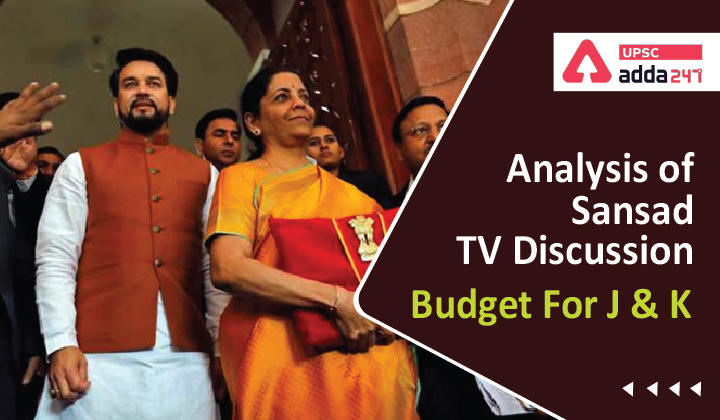Table of Contents
Analysis Of Sansad TV Discussion: ”Budget For J & K”
Relevance
GS 2 & GS 3: Constitutional Amendments, Budget
Context
- Recently, the budget for the Union Territory of Jammu & Kashmir for 2022-23 was passed by Lok Sabha.
- Along with the budget, the FM also presented supplementary demands for grants, demands for grants and demands for excess grants for Jammu and Kashmir in the lower house of parliament.
Background
- This is the second half of the Budget session which will conclude on April 8. The first half of the budget session began on January 31 and concluded on February 1.
- The annual budget of the union territory is required to be presented and approved by Parliament as there is no legislature in Jammu and Kashmir currently.
- In the Union Budget for 2022-23, the central government had budgeted a transfer of Rs 35,881.44 crore to Jammu & Kashmir, compared with Rs 34,704.46 crore as per revised estimates of 2021-22.
Key Provisions
- Union Finance Minister Nirmala Sitharaman presented a Rs 1.12 lakh crore Budget for the Union Territory of Jammu & Kashmir for 2022-23.
- Education, home, public health engineering, and power development saw the highest allocations for the UT in the next financial year.
- Capital expenditure is estimated to be Rs 41,335 crore in 2022-23, 17.4 per cent higher than the revised estimates for this fiscal, while revenue expenditure is estimated to increase 6.5 per cent to Rs 71,615 crore.
- For 2022-23, the highest allocation has been for the education department at Rs 11,832 crore, followed by Rs 10,830 crore for the home department and Rs 9,856 crore for the public health engineering department. The power development department has been allocated Rs 8,767 crore, while Rs 7,872 crore has been allocated for the health and education department.
- A supplementary demand for grants was also introduced by the minister for 2021-22 for the amount of Rs 18,860 crore.
Receipt and Expenditure
- Out of the total receipts of Rs 1.12 lakh crore, J&K’s own revenues (both tax and non-tax) are estimated to be Rs 25,314 crore in 2022-23. The SGST collection has been Rs 1,897 crore up to February this year as against Rs 1,389 crore last fiscal.
- For Industries and Commerce, capital expenditure is estimated to be Rs 555.80 crore, Rs 139.84 crore more than the previous year’s budget allocation.
- For the rural sector, an allocation of about Rs 4,627.85 crore has been made under Capital Expenditure for the year 2022-23, which is Rs 327.40 crore more than the previous year’s budget allocation.
- Capital expenditure for the power sector is estimated to be Rs 2,457.58 crore, while that for the school and higher education sector is estimated to be Rs 1,806.66 crore.
What GOI is doing for the development of J & K?
Focus on development through investment
- Rs 44,177 crore investment received so far with an employment potential of 1.80 lakh jobs.
- Investment proposals under the new industrial policy are cleared on a fast track basis and the power generation capacity is doubled in the next three years.
Connectivity
- Connectivity is high on the centre’s development agenda.
- Four National Highway projects are being completed during 2022.
- Execution of Delhi-Amritsar-Katra Expressway is being taken up and 10 new road/tunnel projects have been agreed by MORTH under Bharatmala.
- The world’s highest 1315-meter long railway bridge over River Chenab is targeted for completion by September 2022.
Projects under the Prime Minister’s Development Package
- These projects have seen an expenditure of Rs 36,112 crore.
- A total of 25 projects have been substantially completed and another four projects are likely to be completed by end of the current financial year.
- Against 9,229 works/projects under various sectors/schemes completed in 2018-19, 12,637 works/projects were completed in 2019-20.
- 21,943 works/projects have been completed in 2020-21.
- During the current financial year 2021-22 already 25,446 works/projects under different sectors/schemes have been completed.
What Has Changed in J & K?
- A whole lot of financial reform has taken place since 2019.
- As per CMIE, the rate of unemployment has reduced to 13.2 per cent.
- Rs 2,8400 crore for new central schemes for industrial development. Rs 1,353 crore given as economic package by PM Modi post 370 removal; Rs 750 crore has already been provided to 3.44 lakh account holders as 5 per cent interest subvention.
Medical Infrastructure
- Oxygen generation plants have increased by 87 with 90,300 litres per minute capacity addition.
- Two 500-bed hospitals were set up by DRDO in Jammu and Srinagar for the Covid-19 pandemic.
How the removal of Art. 370 boosting the economy of J & K?
- Earlier there was a lack of normalcy in Kashmir as the Constitution of India was not applicable there.
- We were shown fake normalcy since 1947 under the garb of Article 370.
- Now, after the removal of 370, Kashmir has real normalcy.
- Kashmiris were denied rights enshrined by Constitution all these years.
- After the removal (of Art 370), 890 central laws have now become applicable to Jammu and Kashmir.
- The removal will give people their rights. The rights that were enshrined in the Constitution made by Dr Ambedkar are now available to the people of Kashmir.
- The UT’s economy is expected to grow by 7.5 per cent on current prices during 2021-22. For next fiscal, tax/GDP ratio is projected at 8.18 per cent, which is higher than 8.17 per cent this fiscal.
- The debt/GDP ratio for 2022-23 is estimated at 50.84 per cent.



 TSPSC Group 1 Question Paper 2024, Downl...
TSPSC Group 1 Question Paper 2024, Downl...
 TSPSC Group 1 Answer key 2024 Out, Downl...
TSPSC Group 1 Answer key 2024 Out, Downl...
 UPSC Prelims 2024 Question Paper, Downlo...
UPSC Prelims 2024 Question Paper, Downlo...




